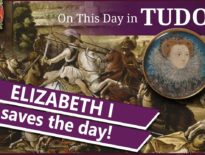On this day in Tudor history, 14th September 1540, Sir William Kingston, Constable of the Tower of London, Knight of the Garter and comptroller of the King's household, died at his home in Painswick in Gloucestershire.
Sir William Kingston was Constable of the Tower of London while Queen Anne Boleyn was imprisoned there in May 1536, and his letters to Thomas Cromwell are an excellent primary source for historians, but there's much more to this royal servant than that. He had a wonderful career in service to the king and benefited as a result.
Find out more about Kingston in today's talk.
Also on this day in Tudor history, 14th September 1538, the Shrine of Our Lady of Caversham, which had stood since the early 12th century, was destroyed on the orders of King Henry VIII.
Hear contemporary accounts of the shrine's destruction, which include details of what was seized and sent to London, in last year’s video:
Also on this day in history:
- 1514 – Second proxy marriage of King Louis XII of France and Mary Tudor, sister of Henry VIII.
- 1523 – Death of Pope Adrian VI in Rome. He was buried in Rome's Santa Maria dell'Anima church. Adrian had only been Pope since January 1522.
- 1585 – Sir Francis Drake set sail from England on a mission to raid Spanish ports. He had been given royal approval for these raids, and raids in the West Indies at the end of 1584.
Transcript:
On this day in Tudor history, 14th September 1540, Sir William Kingston, Constable of the Tower of London, Knight of the Garter and comptroller of the King's household, died at his home in Painswick in Gloucestershire.
If you followed my videos counting down to the execution of Anne Boleyn, his name will be familiar to you as he was Constable of the Tower of London and his letters to Thomas Cromwell regarding the prisoners in the Tower that May are an excellent resource for historians.
But let me tell you a bit more about Sir William Kingston...
Kingston was born in around 1476. His origins are unknown but historian Stanford Lehmberg believes that he was from a Gloucestershire family who were related to the barons Berkeley of Berkeley Castle, Gloucestershire, and also to Edward Stafford, 3rd Duke of Buckingham. Kingston had a brother named George.
In 1497, Kingston was appointed as a yeoman of the chamber to Henry VII and served in this position until the king’s death in 1509. In 1506, he became a Justice of the Peace for Gloucestershire. At Henry VII's funeral in 1509, he served as a gentleman usher. In 1511 and 1512, he served in the army of Henry VIII and in September 1513 he fought at the Battle of Flodden against the Scots. He was knighted in October 1513.
In 1514, Kingston was made a king's sewer and a sheriff of Gloucestershire, and in 1519, Cardinal Wolsey chose him to be a knight of the body in the privy chamber following Wolsey's purge of the privy chamber in the Eltham Ordinances. He continued to serve the king as keeper of the king's jewels and plate and then as a carver in 1521.
In 1520, Kingston attended the king at the Field of the Cloth of Gold and in 1521 he served on the jury that found his relative Edward Stafford, 3rd Duke of Buckingham, guilty of treason. Buckingham was executed and Kingston was made constable of Buckingham’s former home, Thornbury Castle, Master of the Hunts in Gloucestershire, and steward and bailiff of the Gloucestershire properties and land that had belonged to the duke. In 1523, Kingston served under the Earl of Surrey campaigning in Scotland before serving the Duke of Suffolk in France.
Kingston was appointed Constable of the Tower of London on 28th May 1524 and between 1529 and 1536 he served as a member of Parliament for Gloucestershire. He accompanied the king and his sweetheart, Anne Boleyn, to Calais in October 1532 for their meeting with King Francis I of France.
As I said, Kingston is best known for his role in the imprisonment of Anne Boleyn in May 1536. His third wife Mary (née Scrope) was appointed to serve Anne Boleyn during her time in the Tower and reported to Kingston on Anne's behaviour and what she said so that Kingston could pass on the details to Cromwell. Kingston seems to have treated Anne Boleyn with respect and sympathy while she was imprisoned in the Tower. When Anne was upset about the postponement of her execution, saying that she thought to be past her pain by that time, Kingston comforted her saying that the blow of the sword would be "so subtle". He was also concerned about Anne's brother George's peace of mind, while he was awaiting execution. George was fretting that his debtors would not be paid after his death and that they would end up getting into trouble if they had to pay the King instead. Kingston wrote to Thomas Cromwell twice about George, begging him to "help my lord of Rochford's conscience".
Other high profile prisoners he was in charge of include Cardinal Thomas Wolsey, whom he was ordered to escort from Yorkshire to London in November 1529, and Thomas Cromwell at his fall in 1540.
Kingston benefited from the dissolution of the monasteries when he was awarded the land and possessions associated with the abbey of Flaxley in Gloucestershire in 1537. In 1539 he was appointed Comptroller of the King's Household and became a Knight of the Garter. After Cromwell's execution in July 1540, he was able to buy Cromwell's property in Gloucestershire, the manor of Painswick and Morton Valence. He died at Painswick on this day in 1540 and was buried at Painswick.
Kingston was married three times. His first wife was Anne, widow of Sir John Guise; his second wife was named Elizabeth, and his third wife was Mary, daughter of Richard Scrope and widow of Edward Jerningham. He had one son, Sir Anthony Kingston, who is thought to have been born around 1508, and either one or two daughters.



Leave a Reply